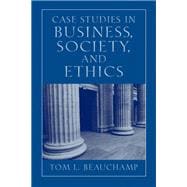
Note: Supplemental materials are not guaranteed with Rental or Used book purchases.
Purchase Benefits
What is included with this book?
| Employees and the Workplace | |
| Employee Recommendations and Grievances | |
| Peer Review of Grievances at Shamrock-Diamond Corporation | |
| Employee Privacy | |
| Drug Testing at College International Publishers | |
| The Open Door at IBM: What Can Company Doctors Disclose? | |
| Sexual Harassment | |
| Managing the Crisis at Mitsubishi Motors | |
| Awkward Advances at Your Old House Magazine | |
| Whistle-Blowing | |
| An Explosive Problem at Gigantic Motors | |
| The Reluctant Security Guard | |
| Customers, Clients, and Consultants | |
| Marketing | |
| KCRC's Incentives for Advertisers | |
| Pornography's Many Markets and Distributors | |
| Selling to Unethical Customers | |
| Ellen Durham's Dilemmas Over a Customer Base | |
| Confidentiality of Financial Information | |
| Confidential Accounts at Swiss Bank Corporation | |
| Conflict of Interest | |
| Commissions at Brock Mason Brokerage | |
| Consulting for Jones and Jones Pharmaceutical | |
| Accountants as Consultants | |
| Arthur Andersen's Dual Role at Enron | |
| Stakeholder Interests and Government Interests | |
| Intellectual Property on the Internet | |
| Napster's Free Market in Intellectual Property | |
| Regulating the Entertainment Industry | |
| Violent Music: Sony, Slayer, and Self-Regulation | |
| The Ban on Insider Trading | |
| An Accountant's Small-Time Trading | |
| Corporate Campaign Contributions | |
| Lockheed Martin's Acquisition of Comsat | |
| Corporate-Government Tensions | |
| Italian Tax Mores | |
| Noneconomic Issues Presented by Shareholders | |
| Pate at Iroquois Brands | |
| Environmental Protection and Government Regulation | |
| Regulating Emissions: From Acid Rain to Global Warming | |
| How Reserve Mining Became Cleveland-Cliffs | |
| Competitive Markets | |
| Sharp Practices | |
| Seizure of the S.W. Parcel | |
| Conflict of Interest | |
| Edward Reece's Search for Contractors | |
| Lilly's Consultation with Hostile Corporations | |
| Exploiting Trade Secrets and Practicing Due Diligence | |
| Venture Capital for Rubbernex Paints | |
| Advertisements for Tobacco and Alcohol | |
| Marketing Alcholic Beverages and Its Impact on Underage Drinkers | |
| Banning Cigarette Advertising | |
| "Sweatshops" and "Advertising" to Defend Them | |
| Nike's Defense of its Vietnamese Factories | |
| Problems of Justice: The Unfair and | |
| Table of Contents provided by Publisher. All Rights Reserved. |
The New copy of this book will include any supplemental materials advertised. Please check the title of the book to determine if it should include any access cards, study guides, lab manuals, CDs, etc.
The Used, Rental and eBook copies of this book are not guaranteed to include any supplemental materials. Typically, only the book itself is included. This is true even if the title states it includes any access cards, study guides, lab manuals, CDs, etc.